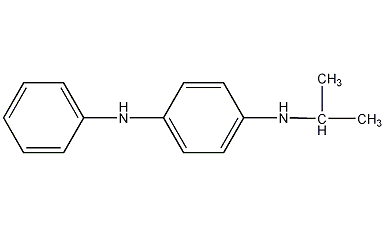
Structural formula
| Business number | 02KZ |
|---|---|
| Molecular formula | C15H18N2 |
| Molecular weight | 226.32 |
| label |
N-(1-methylethyl)-N’-phenyl-1,4-phenylenediamine, N-phenyl-N’-isopropyl-p-phenylenediamine, Anti-aging agent IPPD, Antioxidant 4010NA, N-(1 – methyl-ethyl)-N ‘- phenyl-1,4 – phenylenediamine, N-phenyl-N’-isopropyl-p-phenylenediamine, Catalysts and auxiliaries, rubber additives, Anti-aging agent |
Numbering system
CAS number:101-72-4
MDL number:MFCD00026348
EINECS number:202-969-7
RTECS number:ST2650000
BRN number:None
PubChem ID:None
Physical property data
1. Properties: The pure product is white flaky crystals, which will gradually turn purple-gray when exposed to sunlight.
2. Relative density (g/mL, 20℃): 1.14
3. Relative vapor density (g/mL, air=1): Undetermined
4. Melting point (ºC): 80.5
5. Boiling point (ºC, normal pressure): 366
6. Boiling point (ºC, 4mmHg): Undetermined
7. Refractive index: Undetermined
8. Flash point (ºC): Undetermined
9. Specific rotation (º): Undetermined
10. Autoignition point or ignition temperature (ºC): 560
11. Vapor pressure (mmHg, 20.2ºC): Undetermined
12. Saturated vapor pressure (kPa, 25ºC): Undetermined
13. Heat of combustion (KJ/mol): Undetermined
14. Critical temperature (ºC): Undetermined
15. Critical pressure (KPa): Undetermined
16. Log value of oil-water (octanol/water) partition coefficient: Undetermined
17. Explosion upper limit (%, V/V) : Undetermined
18. Lower explosion limit (%, V/V): 20 (g/m3)
19. Solubility: insoluble in water, gasoline, soluble in oils , benzene, ethyl acetate, carbon tetrachloride, methylene chloride, etc.
Toxicological data
1. Skin/eye irritation: Standard Dresser test: rabbit eye contact, 100mg/24HREACTION SEVERITY, moderate reaction
2. Acute toxicity: rat oral LD50: 720mg/kg; Mouse oral LD50: 1122mg/kg; rabbit oral LD: >7500mg/kg
Ecological data
This substance may be harmful to the environment and it is recommended not to let it enter the environment.
Molecular structure data
1. Moore’s foldEmissivity: 74.46
2, Molar volume (cm3/mol): 208.3
3, Isotonic specific volume (90.2K): 536.4
4. Surface tension (dyne/cm): 43.9
5. Dielectric constant:
6. Dipole moment (10-24cm3):
7. Polarizability: 29.51
Compute chemical data
1. Reference value for hydrophobic parameter calculation (XlogP): None
2. Number of hydrogen bond donors: 2
3. Number of hydrogen bond acceptors: 2
4. Number of rotatable chemical bonds: 4
5. Number of tautomers: none
6. Topological molecule polar surface area 24.1
7. Number of heavy atoms: 17
8. Surface charge: 0
9. Complexity: 201
10. Number of isotope atoms: 0
11. Determine the number of atomic stereocenters: 0
12. Uncertain number of atomic stereocenters: 0
13. Determine the number of chemical bond stereocenters: 0
14. Number of uncertain chemical bond stereocenters: 0
15. Number of covalent bond units: 1
Properties and stability
1. Avoid contact with strong oxidants.
2. The pure product is white flake crystal, which will gradually turn purple-gray when exposed to sunlight.
3. Soluble in oil, benzene, carbon tetrachloride, ethyl acetate, methylene chloride, chloroform, carbon disulfide, acetone and ethanol, insoluble in gasoline and insoluble in water. Low toxicity.
Storage method
Store in a cool, ventilated warehouse. Keep away from fire and heat sources. Protect from direct sunlight. The packaging is sealed. should be kept away from oxidizer, do not store together. Equipped with the appropriate variety and quantity of fire equipment. Suitable materials should be available in the storage area to contain spills.
Synthesis method
P-Aminodiphenylamine (i.e. RT base) reacts with acetone in the presence of copper-chromium catalyst at 160-165℃ and hydrogen pressure of 5-6MPa. The reactants are filtered while hot to remove the catalyst, and the finished product is obtained by freezing, crystallizing, filtering and drying. Isopropyl alcohol can be recovered by distillation by filtering the mother liquor. Raw material consumption (kg/t) RT Base 875 Acetone 420 Catalyst 12 Hydrogen 60

Purpose
1. This product is used as a rubber antioxidant, especially suitable for natural rubber, styrene-butadiene rubber, nitrile rubber, chloroprene rubber, butadiene rubber and isoprene rubber. It can be used for both vulcanized rubber and unvulcanized rubber. of rubber. It has excellent protective effect against ozone and flexural fatigue; it also has good protective effect against general aging such as oxygen and heat; it also inhibits the damage of harmful metals such as copper and manganese to rubber. This product is often used in the manufacture of rubber products that are subject to high dynamic and static stress, such as aircraft and car tires, bicycle tires, cables, hoses, tapes, rubber rollers, etc. When the dosage is 2.5 to 3 parts in natural rubber and less than 4 parts in styrene-butadiene rubber, blooming will not occur. The effect of using this product together with antioxidant AW, antioxidant BLE or wax physical protective agent is more significant, and its dosage can be reduced. This product is polluting and should not be used for light-colored rubber products. Vulcanized rubber containing this product may bleed if it is in long-term contact with strong oxidants or iron salt solutions.
2.Excellent protection against ozone and flexural fatigue; good protection against general aging such as oxygen and heat; against harmful metals such as copper, Manganese also has an inhibitory effect on rubber damage. Used as a rubber antioxidant, it is especially suitable for natural rubber, styrene-butadiene rubber, nitrile rubber, chloroprene rubber, butadiene rubber and isoprene rubber. It can be used in both vulcanized rubber and unvulcanized rubber. It is often used in the manufacture of rubber-based adhesives or rubber products that are subject to high dynamic and static stress, such as aircraft and car tires, bicycle tires, cables, hoses, tapes, rubber rollers, etc. When the dosage is 2.5 to 3 parts in natural rubber and less than 4 parts in styrene-butadiene rubber, blooming will not occur. The effect is more significant when used together with antioxidant AW, antioxidant BLE or wax physical protective agent, and its dosage can be reduced.

 微信扫一扫打赏
微信扫一扫打赏

